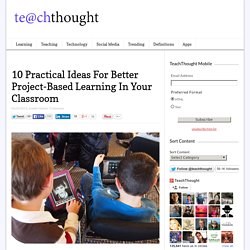

UbD Websites 7.12.12.docx. What Has Aid Ever Done For Anyone? Practical PBL: The Ongoing Challenges of Assessment. In recent years, most students in my project-based AP Government classes have indicated, in both class discussions and anonymously on surveys, that they prefer project-based learning to a more traditional classroom experience.

They find PBL more fun and believe that it leads to deeper learning. However, two types of students often resist this model. Students of the first type generally do not enjoy school at all, and are looking for the path of least resistance. Because a PBL classroom is student-centered and calls on students to produce, less-motivated students will find it more difficult to "hide" and be left alone. The second type of student has already been very successful in traditional classrooms and is deterred by the challenges of this new model. Both types of students benefit from the option of choosing their role in project cycles to increase motivation. Fair Assessment of Teamwork 1) Individual Skill Areas 2) Role-Based Assessment 3) "Weighted" Scoring.
Bloggers on Project Based Learning: PBL Design Deep Dive –What Products, and How Many? When designing a project, teachers frequently ask, “Should my students/teams create:The same product with the same focus or topic?”

The same product, but with a different focus or topic?” A different product with the same focus or topic? "A different product, but with a different focus or topic?” As you have grown accustomed to in PBL, there is no ONE “right” answer to this question. However, I would like to share how four teachers approached this issue. The “same product with the same focus or topic” is often a good option in the elementary grades, or in the secondary grades when the project has a narrow scope of content and/or short duration. One project that fit this bill was a math project designed to teach systems of linear equations and processes to collect, organize and represent mathematical data.
The teacher asked the driving question, “How can we develop an evidence-based recommendation to the White Rock Marathon Committee regarding the use of MP3 devices?” PBL in the English classroom. What makes a hero? - Matthew Winkler. 10 Practical Ideas For Better Project-Based Learning In Your Classroom. By Jennifer Rita Nichols, TeachThought Intern Teachers are incorporating more and more projects into their curriculum, allowing for much greater levels of collaboration and responsibility for students at all levels.

Project- based learning is a popular trend, and even teachers who don’t necessarily follow that approach still see the benefit to using projects to advance their students’ learning. Projects can be wonderful teaching tools. They can allow for a more student-centred environment, where teachers can guide students in their learning instead of using lectures to provide them with information. The increase in classroom technology also makes projects more accessible to students. Despite general agreement about the benefits of using projects and project-based learning in general, it must be noted that all projects are not created equal! This may happen fairly often because teachers are wary about being able to assign grades to the final assignments handed in to them by students. Why English teachers should care about project-based learning: multiliteracies, assessment for learning and digital technologies.
There is impetus for pedagogical change in the English classroom.

Bull and Anstey (2010, p.6) observed that, ‘literacy teaching and learning should respond to the rapid changes in literacy arising from increasing globalization, technology and social diversity.’ This transforming social, cultural and technological landscape necessarily brings with it a new set of opportunities and challenges for secondary English teachers.
Three such challenges include the purposeful integration of digital technologies into the classroom, the use of assessment for learning practices and the emergence of new literacies. The reshaping of traditional teacher-centred pedagogy to a more student-centred, inquiry-based pedagogy may assist Australian secondary English classroom with meeting these new challenges. One alternative pedagogy that may provide teachers with a scaffold to integrate digital technologies, assessment for learning practices and multiliteracies into the English classroom is PBL. Figure 1.